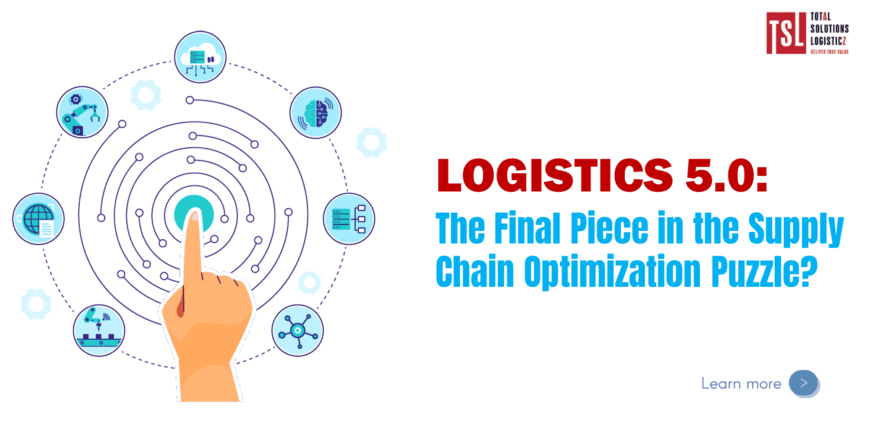Logistics 5.0: The Final Piece in the Supply Chain Optimization Puzzle?
The manufacturing and logistics industry is integrating its ecosystem with cutting-edge new technologies such as the use of IoT in supply chain management. Automation and AI, robotics, language processing and lean manufacturing are experiencing massive and rapid changes in the technologies that control and support them. However, the major difficulties faced by the sector in the time of pandemic have given them an opportunity to learn positive lessons. The need to effectively handle and cope with disruptions triggered a technological change in Logistics 4.0.
How COVID-19 inspired industrial transformation
Logistics demand hit an all-time high with people not being able to move out of their homes, leading to a host of problems such as shortage of containers, new security measures and problems renewing staff, delays, interruptions and much more. It exposed the weaknesses of the classic plans of the logistics industry and accelerated the transition to Logistics 4.0. Companies in this industry have been forced to invest in innovation and technology to increase resilience and competitiveness in the coming future.
With the pandemic likely to end, the productive system will have to change to meet sustainability and digitization simultaneously. This is where Logistics 5.0 comes into the picture. With the need for both sustainability and digitization, Logistics 5.0 is the need of the hour.
Logistics 5.0 – The Final Piece in the Supply Chain Optimization Puzzle?
The core of Logistics 4.0 consists of technology and its amalgamation in the logistics sector. Logistics 4.0 uses information to connect and improve the operations and processes of supply chain management. Blockchain, cloud and other technologies help secure the exchange of data and keep the logistics sector decentralized in a very convenient way.
Smart tools such as management systems for warehouses, pallets, robotic transport and containers act as a pillar for automated supply chains and help to extract and create more value from each piece of equipment. Data readers, smart shelves and autonomous vehicles are some of the smart types of devices that help workers. Artificial Intelligence (AI) is another pillar of Logistics 4.0 which helps in achieving highly efficient supply chain. Logistics 4.0 utilizes prepared and packaged shipments, supplies and orders based on estimated sales forecasts using big data and machine learning.
GPS technology helps the logistics industry by helping to locate the real-time and precise location of cargo and therefore reduce risk, allow route optimization and increase cargo control. RFID tags that are accessible via tablet and mobile provide data that allows operators to interact with and track their business at any time.
All of these technologies, when combined and integrated, promote the performance of the entire supply chain process in terms of flexibility, transparency, integration, efficiency, collaboration, quality and accountability. A cyber-physical system is created on the supply chain by these combined technologies.
This digitization of Logistics 4.0 allows companies to meet the new demands of customers. It ensures that they meet the needs and expectations of the customers on the supply side through efficiency and improvement. Supply Chain 4.0 is flexible, fast and accurate.
However, since Logistics 4.0 separates the operations and functions of machines and humans, revolutionaries are propounding the idea of the fifth industrial revolution or Logistics 5.0, which would bring harmony between humans and machines. Whereas Logistics 4.0 stipulates that better performance is achieved when work is more automated, Logistics 5.0 explores the idea of what benefits can be derived by combining a workforce of humans and machines.
How Logistics 5.0 will change the game?
Logistics 5.0 is the proposed response and solution to the 5.0 industry model. And like Industry 5.0, Logistics 5.0 also focuses on knowledge and sustainability. It is a transition that focuses on workers and minimizes environmental impact. Logistics 5.0 has enabled companies to transition from digital automation to digitization and collaboration of human effort without compromising or neglecting the competitiveness and profitability of their businesses.
The idea of Logistics 5.0 prioritizes integrating the environment with technological innovations. This concept requires the logistics industry to move in three directions: Human factor, Flexibility, Stability
Under Logistics 5.0, workers are considered a long-term investment and their well-being and training is a key concern for the company and its logistics hub. There is a need to change, add and adapt technologies as per the needs and requirements of the workers. This ensures that the company benefits by attracting better talent to work with the company and retaining their services in the long run. This makes it clear that the Logistics 5.0 paradigm involves moving up the game from Logistics 4.0, where there is a reliance on technology to improve and consider ecological and social benefits.
Logistics 5.0 will bring unprecedented reduction in cost, errors and time, paving the way for a better and sustainable logistics industry.
*Source: Forbes









